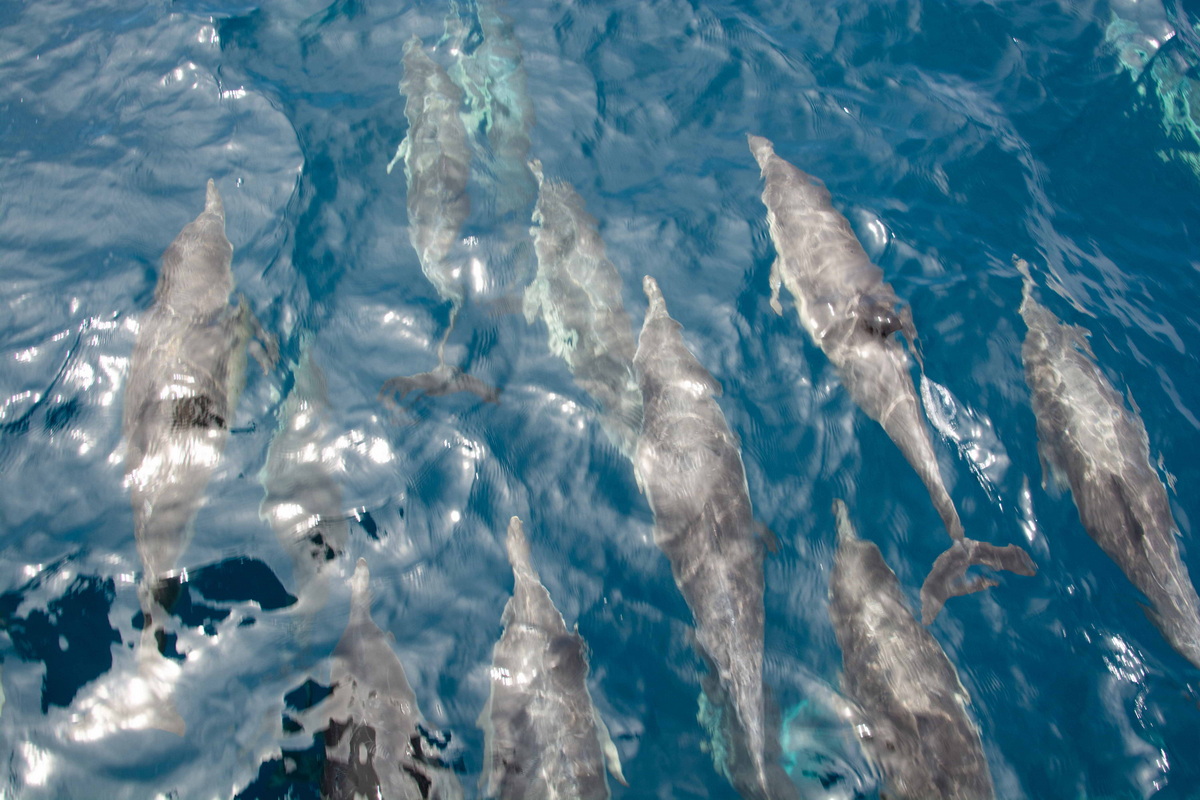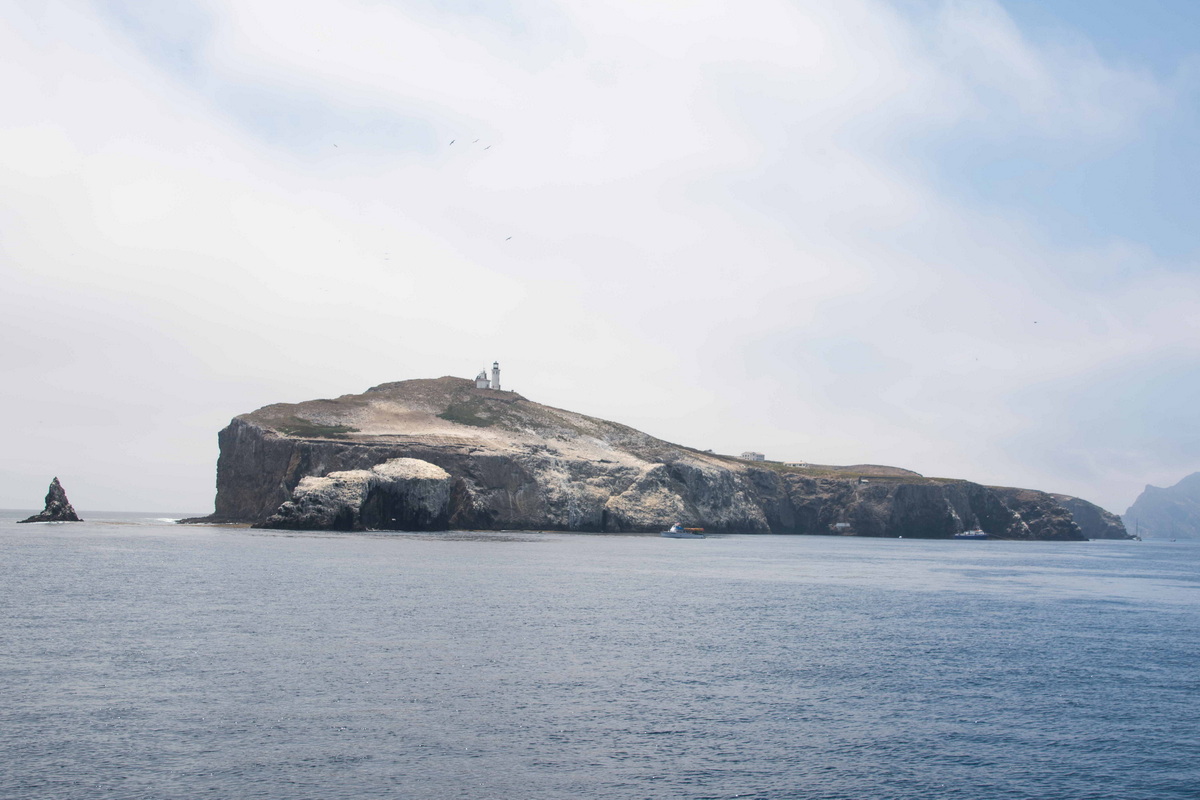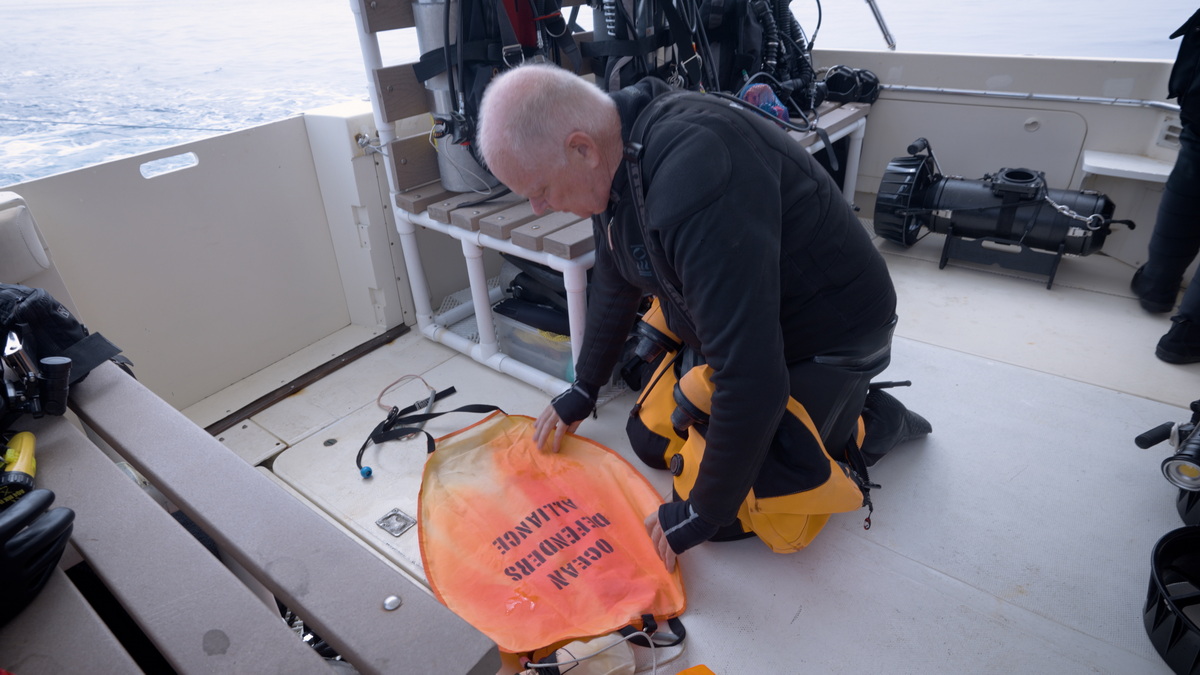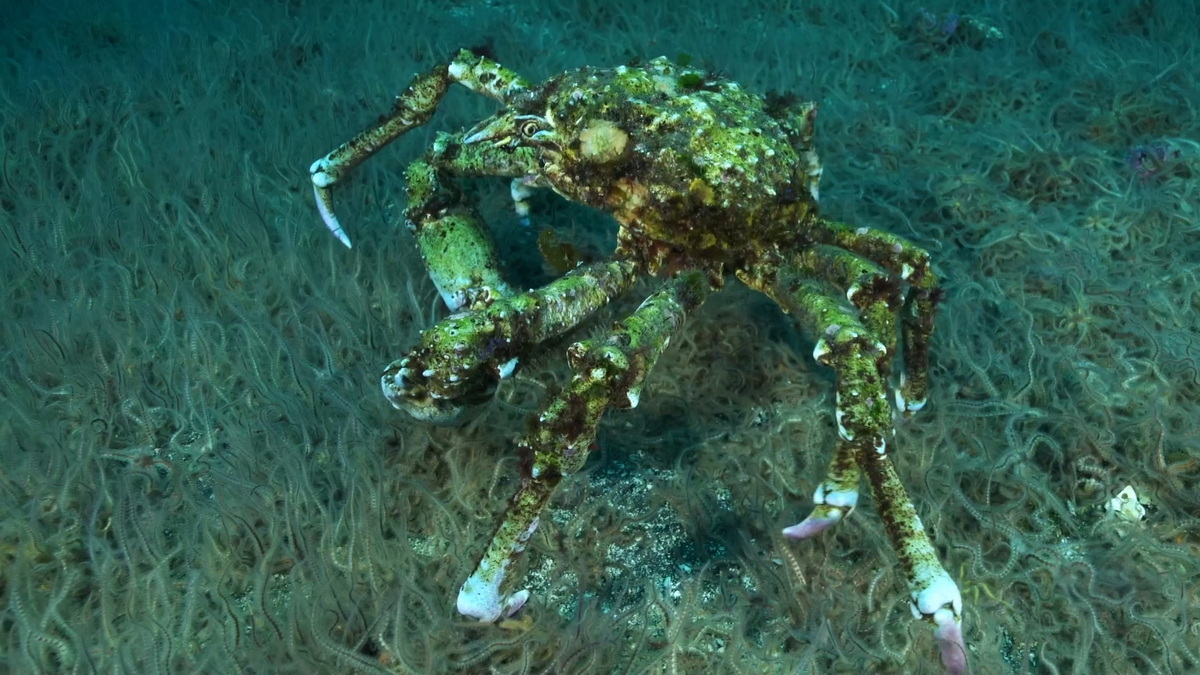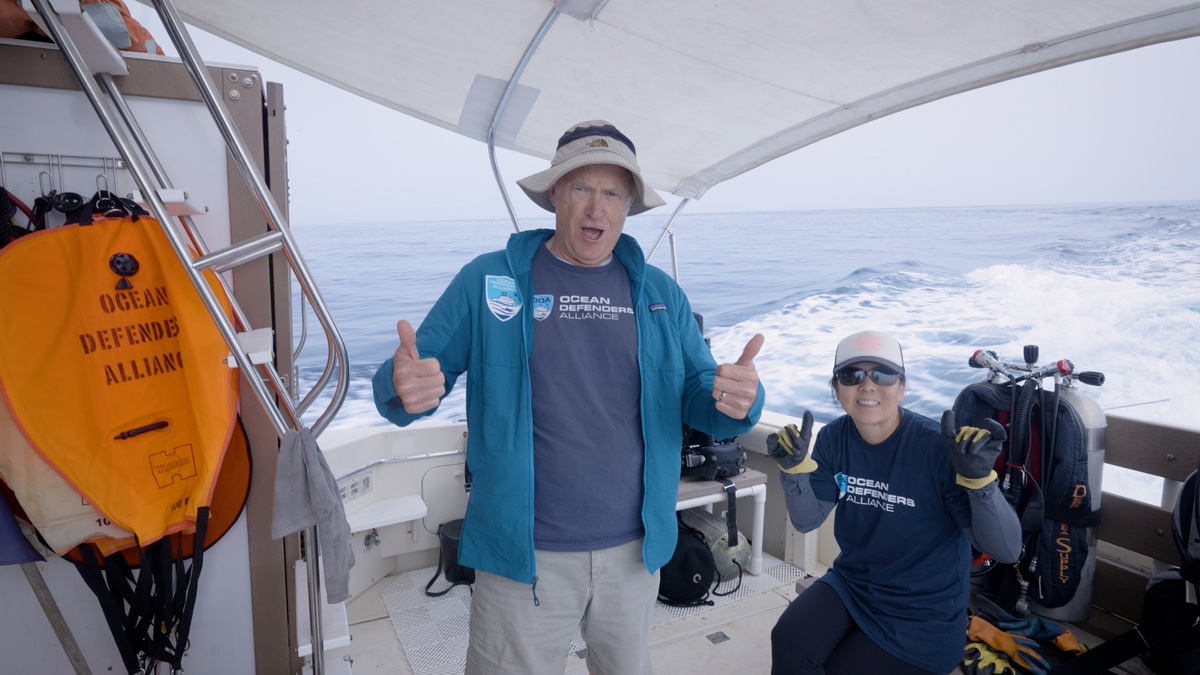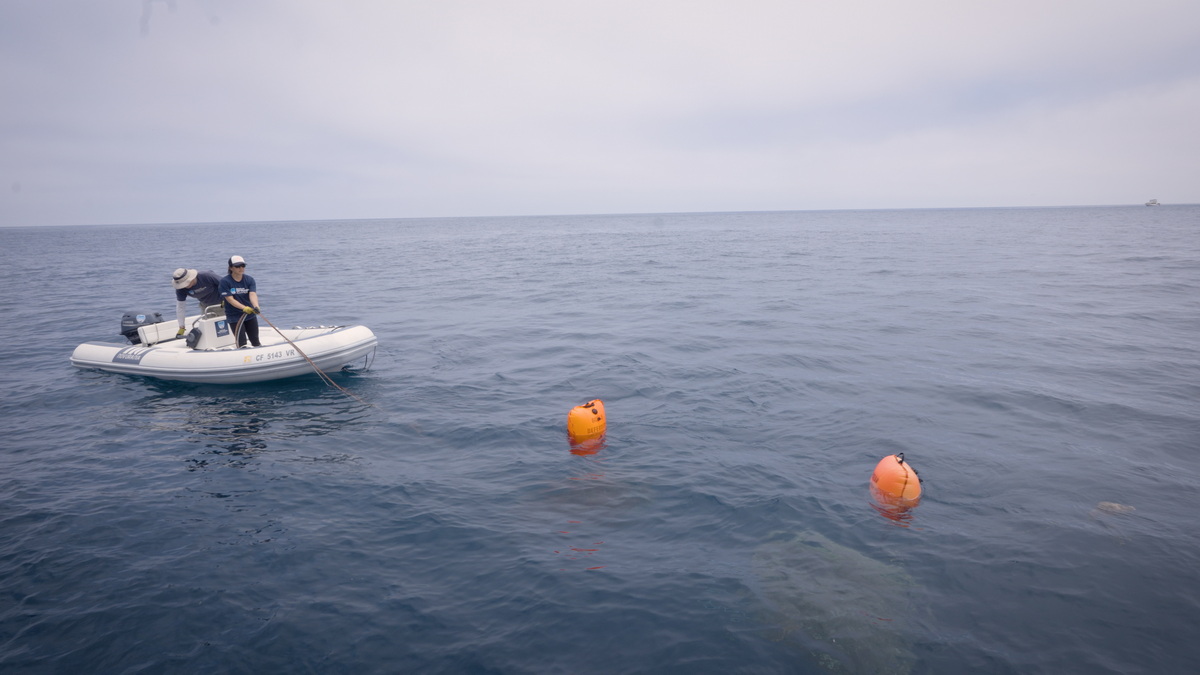By Founder and President Kurt Lieber
Hoping to capitalize on our successful trap removal from Anacapa Island over the Fourth of July weekend, we loaded up all the gear we’d need to get four divers in the water.
Eight of us met at our boat Mr. Barker’s LegaSea slip at 8am on Sunday, July 16th. After stowing all the dive gear on the boat, we lowered the RIB (Rigid Inflatable Boat) into the water and towed it behind us for the 10-mile ride out to the Arch Rock area of East Anacapa Island.
Our crew this day was Kim Cardenas, Nancy Huh, Craig LaPort, Pete Markel, Dave Merrill, Geoff Walsh, Mike Wynd, and me.
As we headed out of the harbor, the fog was so dense that we had to activate our radar unit to make sure we could see electronically what we couldn’t see with our own eyes. At times the visibility was only 200 yards.
Once we got a few miles out the fog lifted, and we were no longer wary of running into another boat.
What we did “run into” was a giant pod of dolphins! Of course, you could never really run into them. They are so adept; they swim alongside and in front of the boat!
It always a huge treat to see our marine mammal friends leaping and speeding through the water, escorting us to our cleanup site. We actually saw another pod on the way home which was just icing on the cake! Be sure to check out the photo gallery below for more images of these graceful creatures.
It took us an hour to get to the site, and we dropped anchor 600 feet from where we found four traps on our last outing.
There's a fair amount of prep work that has to take place. Life bags must be properly folded so they'll be in the proper position to deploy. Air tanks have to be checked. And boat crew help the divers secure their gear.
This time we had the advantage of having four divers. They broke up into teams of two. Craig LaPorte and Mike Wynd both use rebreather systems, so they paired up and jumped in the water first. Twenty minutes later, Kim Cardenas and Geoff Walsh made the plunge, grabbed their scooters, and headed to the anchor line.
All four divers had a really difficult time getting to the anchor line though, as the current was really ripping. So much so that if their scooters had stopped working, they would have quickly been swept out to sea. We deployed what is known as a drift line. This is a long line that’s attached to the boat and floats along the surface behind the boat. If someone were to not be able to make it back to the boat, they could hold onto that line and the deck crew would pull them in.
Once they all got down to the bottom, which was 95-feet deep, they started searching for abandoned traps. For the first half hour it didn’t look very promising, as we didn’t see any lift bags breaking the surface.
Back on the boat, we don't know what the divers are seeing, but thankfully, they had an underwater camera so they could share some shots with us:
They even saw a sheeps crab who avoided getting into the trap (which usually means never exiting)...
But soon enough we saw a lift bag about 150 feet away from the boat! Our RIB crew quickly jumped into action and motored over to the single lift bag. The crew consisted of Nancy Huh (this was her first time out with us!) and Dave Merrill.
Pete and I were holding down the fort on the LegaSea.
By the time they got a tow line hooked up to the lift bag, they were 300 yards away from us. Just as they started towing the contents over to our boat, another bag hit the surface and within minutes the current took it right to Nancy and Dave. They attached another line to that bag and tried to tow it to us.
But the current was too strong for them to make any kind of headway. We just had to wait for all the divers to climb back aboard the LegaSea before we could motor over to the RIB and see what was attached to the two lift bags.
By the time we pulled up the anchor we could barely see the RIB team. They must have been half a mile away by now. Once we got to them, they told us that they had two huge traps. As we got everyone positioned to attach the haul-out line from the davit (crane) to a trap, it was just too heavy to lift and get the end of the line attached to it.
We needed someone who was in the water to assist. Craig kindly agreed to jump in, swim over to the site and hook everything together.
Then we hauled up the two traps.

These were huge traps – probably weighed 100 pounds each – the largest ones we’ve ever seen. Luckily there were no large animals stuck in them, but there was over 100 feet of heavy-duty trap line attached to each one.
Somebody had stuffed one of the trap lines into the trap, but the other one was floating freely in the water column. This is exactly what we don’t want to see underwater, as this can potentially entangle a whale, dolphin, sea lion, or turtle. You can see the line (rope) in our last photo below which we call The Catch of the Day!
Once we had everyone back on the boat, and the traps secured on the front deck, I started up the engines to move back to the same site and look for other traps that the divers had seen. However, they were low on air and had to surface.
By this time, I was having mechanical issues with the engines. I had to turn one of the engines off due to warning signals I was getting from the control system. When we got back to the dive site, the current had picked up even stronger.
All the divers had had a hard time getting back on the boat during the first dive due to that strong current. We decided to call it a day and come back at a later date to give it another try. On the way home, we got our big thank you from another pod of common dolphins:
Thanks, Mike, for getting these great UW shots! And Pete for all the additional topside shots.
Nancy, it was great to have you aboard! You were a big help, and we hope to see you again.
If you’re in the Ventura County area, and like Nancy, you want to give back to the ocean by physically joining the crew, please email us at volunteer@oceandefenders.org.



